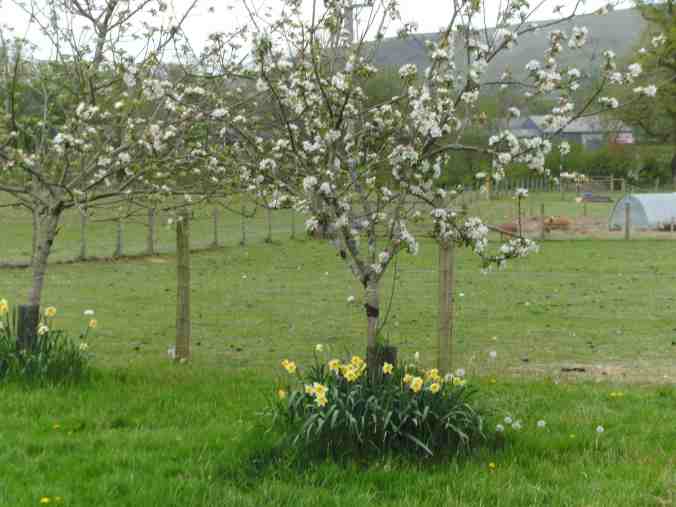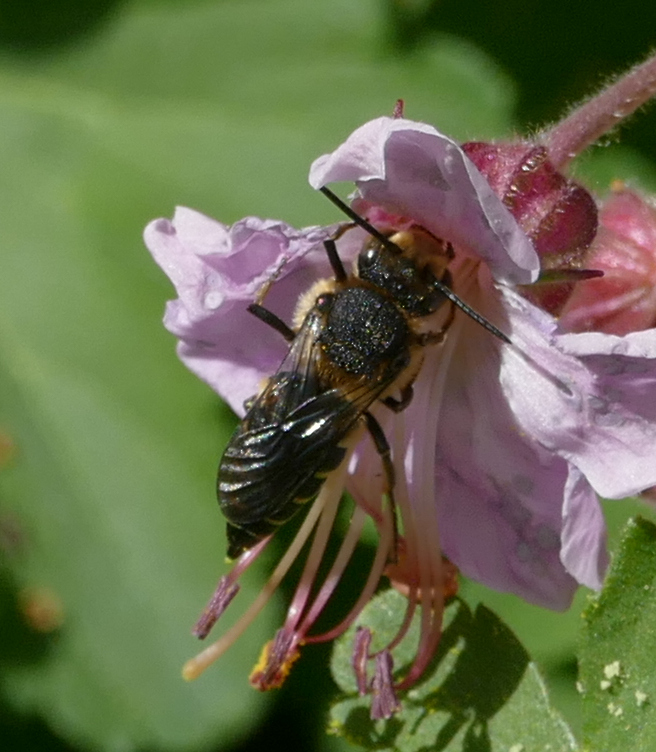Very many thanks to everyone who’s sent words and photos to me recently.
We now know that Wales will remain firmly in lock down mode for at least another 3 weeks, although garden centres have at last been allowed to open again. Perhaps one of the longer term consequences of the pandemic will be an increased awareness of the benefits of gardening to mental and physical health? Sadly we’ve had to cancel Jim Almond’s June talk now, and still have no real sense of when we can all meet up again, so I hope that members enjoy these occasional posts showing where some of us are spending the majority of our time.
(Allium “Purple Rain” above – a new one we tried planting last autumn – maybe it’ll survive better here than others!)
I’m sure most of us feel really fortunate compared to so many at the moment, to enjoy this wonderful West Wales spring, with oodles of time to spend outside in our own havens.
Thanks to Sally for this recent update from her garden:

The long border at the front of the house was planted up last year with hardy perennials most of which were brought from my previous garden in Oxfordshire and supplemented from purchases from local nurseries and plant sales. This was after several months of digging out years of weeds and grass including one border teeming with Spanish bluebells, hah hah, and also having to have large Leylandii tree stumps ground out to release valuable planting space. One of the previous owners had obviously been a keen gardener as there are some good clumps of Astilbes and some well established Azaleas and Rhododendrons in the lower garden, and a raised brick planter with a Japanese Azalea and Pieris which I’ve cloud pruned as it was very straggly.

In spite of the really wet winter everything has come through, though I had thought I’d lost the 2 Rodgersias I bought at the Cothi Gardeners Plant Sale. But yesterday I spotted a pyramid like leaf cluster breaking through, and also my Nepeta govianana is thriving which I could never get through the cold wet winter clay of Oxfordshire. My numerous varieties of Astrantias and Geraniums are looking really good this spring and I’m also pleased with the 2 clumps of Polemonium ‘Hannah Billcliffe’ which looked very sad last year after being kept in pots for a long time. It’s the best Polemonium I’ve ever grown. The original plant from which I’ve taken countless divisions from over the years came from Hannah Billcliffe’s garden which she used to open for the NGS and that was over 30 years ago! I grew the Asphodeline lutea from seed 3 years ago and it started flowering last summer and looks set to be even more profuse this year.

We’re now working on building raised beds in a section of the previous paddock in the back garden for vegetables, and feel at home with the problems of an open windy site as we used to live at the foot of the Berkshire Downs but at least we no longer live in a frost hollow as well! We’re now on a hilltop ridge with panoramic views looking up to Llanllwni Common on one side and north as far as Lampeter and the hills beyond on another side.

Have taken a photo of my greenhouse this morning teeming with seedlings and plants of vegetables and flowers. The Dahlia merkii seeds which I got from you Julian have all germinated but no dark leafed forms.

Thanks to this update too from John and Helen, with some lovely favourites from their garden in early May …

This is cheating a bit. The Magnolia “Sunrise” is actually in a pot (it’s one of Carol’s that is temporarily living with us), but it provides a nice contrast with the Cordyline and the Euphorbia.

Magnolia “Susan” (on the left) – very easy to grow and very reliable.

The Rhododendron is probably “Cosmopolitan” – we got it unlabelled in a hypermarket in France. The Magnolia behind it is “Heaven Scent”, which, unfortunately, doesn’t really live up to its name.

The first flowers opening on R. “Horizon Monarch”.

R. “Picotee” – an absolute stunner.

Prunus “Pink Perfection”, living up to its name.

Prunus “Royal Burgundy”. The combination of light pink flowers and dark pink/purple foliage is particularly striking.

The tree Peony is another of Carol’s plants. It gives a real fillip to a rather dull part of the garden.

R. “Gartendirektor Glocker” . There are scores of plants named after German garden directors, a sure way to achieve immortality.

R. ” Winsome”, slightly out of focus. You win some, you lose some.

M. “Elizabeth”, one of the first yellow Magnolias and still one of the best.

A close-up of P. “Royal Burgundy”

Magnolia “Gold Star”. A fairly recent planting, covered in flower buds and growing apace. It will eventually reach 20ft x 20ft. Just hope some of us are still around to see it.
Thanks too for these from Sandy:

My drive. I just love this view, it’s so pretty. With Ollie dog too.

We’ve just put some wood chippings down and its looking better – hopefully less weeds next year.

A new project – we pulled all the hedges up and are reducing the size of the beds. Grass seed is down awaiting rain.
And thanks too for these from Elena and Andy’s garden…

It’s the end of April, but the “February Gold” daffs under apple trees are in full bloom.

Beautiful Beech tree in its new outfit of spring green.

Meg and in the background Patch enjoying the bluebells.

The crab apple tree covered in blossom, hope we don’t get a frost! ( Oh dear… Ed!! Minus 3 here last night and all my Squash and Courgettes are squished!)

The orchard in full of blossom under a moody sky.
Elena’s also sent in these ideas and suggestions for foraging…
Weeding loads of this right now:

COMMON CLEAVERS (Gallium aparine)
Also known as goosegrass, kisses, sticky bobs, sticky-Willy, sweethearts and Robin-run-the-hedge.
Roast the seeds and used as a coffee substitute. An infusion of the leaves is said to be extremely tasty with a hint of nuts!
From #NatureoftheBreconBeacons Pesda Press books
More about foraging click here, from Robin Hardford’s Eatweeds website.
FORAGING IN SPRING – BECOME A SAFE, CONFIDENT FORAGER, available to buy as a downloadable PDF from Robin’ website, as well as ebooks and physical books for sale.
Covers the fifteen most common wild plants found in Spring.
Each plant notebook covers the past and present uses of wild plants as food and medicine.
They are delivered immediately as downloadable PDFs. So you can keep them on your mobile device when you go out foraging.
No need to drain your monthly data package. And no need to be connected to the internet.
Each notebook includes:
* MULTIPLE COLOUR PHOTOS of each plant MAKE IDENTIFICATION EASY.
* Discover the food and medicine uses of wild plants.
* Learn the folklore and plant stories.
* Includes delicious recipes.
* Know which part of the plant to use.
* When the best time to harvest is.
* In-depth nutritional profiles for each plant are covered.
* Cautions and contraindications – what you need to know.
ABOUT THE AUTHOR
Robin Harford is a plant-based forager, ethnobotanical researcher and wild food educator. He has published over 50 foraging guide books.
He established his wild food foraging school in 2008, and his foraging courses were recently voted #1 in the country by BBC Countryfile.
Robin is the creator of Eatweeds, which is listed in The Times Top 50 websites for food and drink.
He has travelled extensively documenting and recording the traditional and local uses of wild food plants in indigenous cultures, and his work has taken him to Africa, India, SE Asia, Europe and the USA.
Robin regularly appears on national and local radio and television. He has been recommended in BBC Good Food magazine, Sainsbury’s magazine as well as in The Guardian, The Times, The Independent, The Daily Telegraph etc.
Of course still in lock down, we’re not allowed any garden visitors, but rising early as I do to try to film the garden and capture the bird song… I sometimes find some uninvited, though very welcome guests, checking up on how the garden’s looking…

Finally, I don’t know how many Cothigardeners know about the Steven Falk and Richard Lewington “Field Guide to the Bees of GB and Ireland” book which was very kindly given to me as a thank you for my time as chair. Thanks to this and the wonderful weather I’ve been able to identify at least 3 new bee species in the garden here this year…
The Red Mason bee, Osmia bicornis, which wasn’t interested in stone work, but has hunkered down in the screw holes of our terrace table… 

and gone in for a bit of amorous behaviour on the outside of one of our bee hives…

But obviously didn’t appreciate the close observation, so quickly dropped down…

… rolled over…

… and fell from view. Well spring’s in the air after all.

And yesterday, and named for obvious reasons, a Sharp-Tail Bee, one of a number of Coelioxys spp. Which species I’m not sure – but they’re apparently all what’s known as “clepto” parasites of the leaf cutter bees. So watch out Leafcutters – the sharp tail is used by the female bee to cut into the larval cell made by the leaf cutter of rolled up leaf pieces, so that the female bee can then deposit her own egg inside.
Always lots to see and learn outside isn’t their?
Finally, as always, it would be lovely to keep hearing from members about their favourite plants, or things in their gardens as we go through the next few months.
Perhaps you can all send details about what got zapped by the recent frosts??
Why not write a few words and send an image or two, preferably resized down to less than 1 MB? I can’t promise to put everything up online immediately, but usually within a fortnight, and it’s a great way of keeping in touch and passing on information.
Or use the Cothigardeners Facebook Page.
You can send things to me at:
Cothigardeners@gmail.com
Thanks again to all who have contributed to this post.